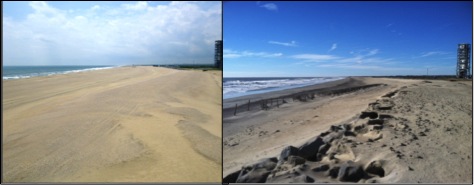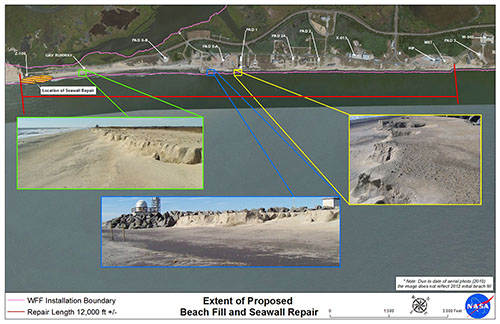Contact: Marjorie Weisskohl
703-787-1304
As part of President Obama’s continuing commitment to help protect and restore coastal areas damaged by Hurricane Sandy, the Bureau of Ocean Energy Management (BOEM) today announced an agreement with the National Aeronautics and Space Administration (NASA) and the U.S. Army Corps of Engineers (USACE) authorizing the dredging of up to one million cubic yards of sand from the outer continental shelf to restore the shoreline at NASA’s Wallops Island Flight Facility in Virginia. The project will provide material to restore more than 2 miles of beach and dunes that protect some of NASA’s most critical launch assets. In addition, the ecosystem restoration project will create new shorebird and sea turtle nesting habitat.
“BOEM’s contribution of sand for this federal facility will help maintain the physical integrity of NASA’s valuable launch infrastructure at Wallops Island and improve resiliency against future storms,” said BOEM Director Tommy P. Beaudreau. “This project is an example of the federal family working together on the ongoing response to Hurricane Sandy,” Beaudreau added.
Dredging operations are expected to begin in the spring of 2014 and take place at an offshore sand borrow area managed by BOEM about 14 miles east of Wallops Island. The Norfolk District of the U.S. Army Corps of Engineers, working with NASA, anticipates the project will take from two to three months to complete.

Since Hurricane Sandy struck, BOEM has been working with the U.S. Army Corps of Engineers, other members of the Federal government’s Hurricane Sandy Task Force, state geological surveys and other entities to analyze the needs for coastal restoration and to develop restoration plans for the 13 states affected by the storm.
BOEM has the authority to convey, on a noncompetitive basis, the rights to resources for shore, beach or wetland restoration projects, or for use in construction projects funded in whole or part, or authorized by the federal government. In exercising this authority, BOEM may issue a negotiated non-competitive lease agreement for the use of Outer Continental Shelf (OCS) sand to a qualifying entity.
Over the past 20 years, BOEM has invested more than $30 million to identify non-energy resources on the OCS, conduct world-class scientific research, and lease OCS resources to coastal communities in need. Information from environmental research and resource identification has informed environmental assessment and leasing decisions concerning the use of OCS sand resources in beach nourishment and coastal restoration. For more information on BOEM's Marine Minerals Program, visit: http://www.boem.gov/MarineMineralsProgram.
The Bureau of Ocean Energy Management (BOEM) promotes energy independence, environmental protection and economic development through responsible, science-based management of offshore conventional and renewable energy resources.

